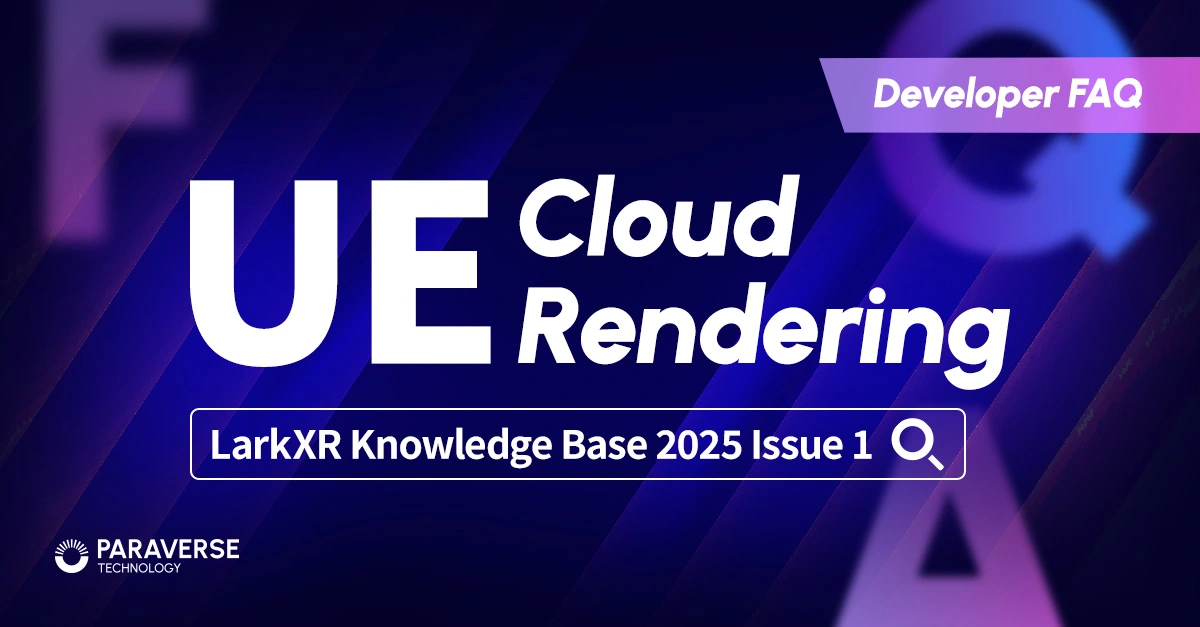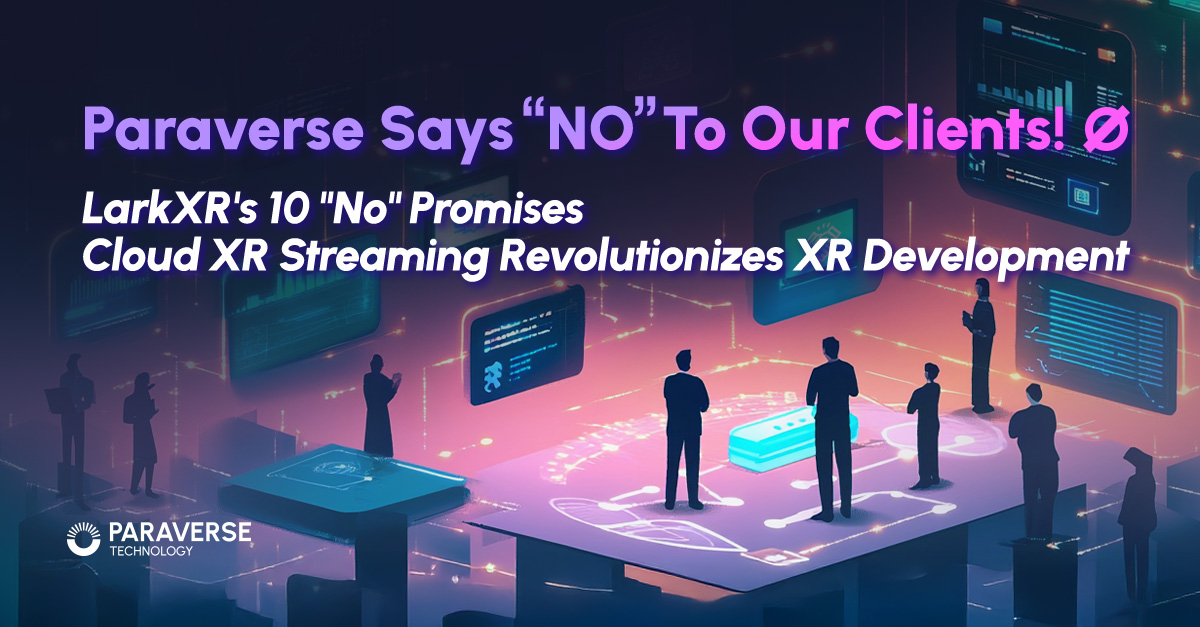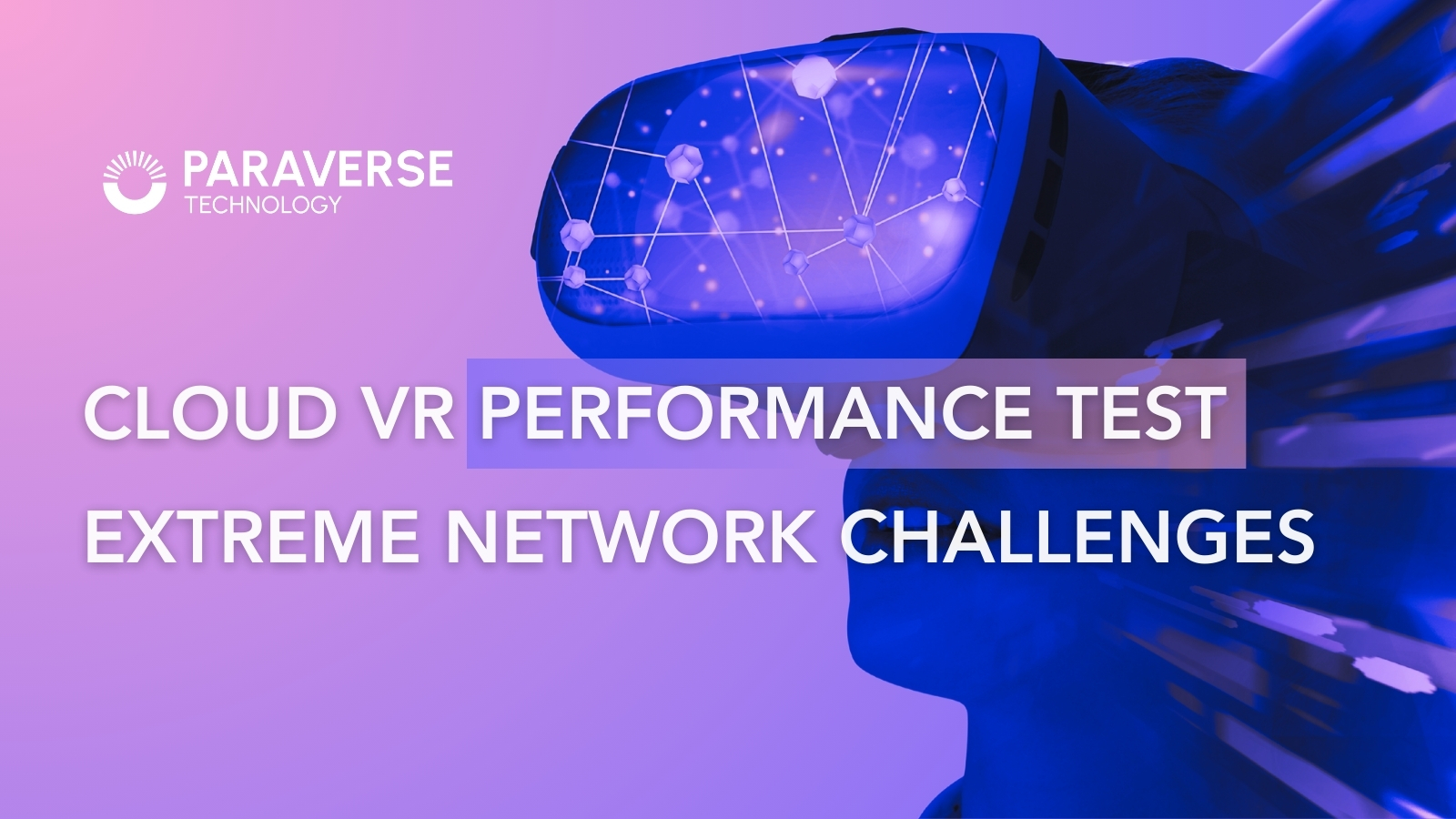

LarkXR Excellence Through Packet Loss, Bandwidth Limits & Dynamic Scenarios
Cloud VR has become an important approach for VR applications, with its key features being cloud-based content and rendering. By fully leveraging powerful cloud computing capabilities, it enhances the VR user experience while significantly reducing terminal device costs. This model allows users to run complex VR applications that typically require high-performance PCs on more portable VR standalone devices, thereby accelerating the widespread adoption and implementation of VR technology.
From education and training to gaming entertainment, from product demonstrations to remote collaboration, cloud rendering technology is showing its transformative potential across various industries. In cloud VR systems, network transmission quality directly determines the end-user experience. Although with the rapid development and popularization of Wi-Fi and 5G communication technologies, today’s wireless networks can provide higher bandwidth, lower latency, and more stable connections, how to maximize the use of existing network infrastructure through advanced audio and video network transmission optimization technologies to ensure smooth cloud VR experiences remains a major challenge facing the industry.
This article focuses on comparing and analyzing the network transmission performance of different cloud VR products and does not involve evaluation of other functional aspects.
Special Requirements of Cloud VR Applications
Cloud VR has fundamental differences in network requirements compared to streaming, video conferencing, and other audio-video application scenarios. It requires:
- Higher bandwidth demands
- Lower latency requirements
- Stronger network jitter tolerance capability
Many cloud rendering platforms are developed based on Google’s WebRTC framework, which is sufficient for general application scenarios but struggles to meet the stringent requirements of cloud VR. The traditional transmission control strategies adopted by WebRTC have limitations: such as AIMD (Additive Increase, Multiplicative Decrease) bandwidth adjustment schemes, retransmission-based packet loss recovery mechanisms, and XOR FEC error correction schemes, which can cause serious inter-frame delays in cloud VR scenarios due to packet loss retransmission, not only affecting the user experience but potentially causing discomfort symptoms such as dizziness.
Paraverse Cloud XR Streaming’s Technical Strength: Continuous Optimization of Cloud VR Network Transmission
Since its establishment, Paraverse has consistently adhered to a “user-centered” product philosophy, continuously pursuing the ultimate user experience. Our R&D team has never stopped optimizing product performance, continuously iterating and upgrading network transmission technology to provide users with a more stable and smooth cloud VR experience.
To address the network transmission pain points in the cloud VR field, LarkXR has established three core technical advantages through long-term technical accumulation and continuous optimization:
- Adaptive high-range bandwidth active detection mechanism
- Adaptive speed regulation mechanism
- High-bandwidth oriented FEC error correction mechanism
This complete transmission technology system can track dynamic changes in network conditions in real-time, significantly enhancing the stability and efficiency of data transmission while fully considering the application characteristics of cloud VR. It ensures users can obtain a clear, smooth, low-latency immersive experience under various complex network environments, effectively avoiding common issues like stuttering, blurring, and dizziness found in traditional solutions.
Network Resilience Showdown: LarkXR vs. Virtual Desktop in Demanding Cloud VR Environments
To verify the performance advantages of LarkXR, we designed multiple network challenge scenarios and conducted comprehensive comparative tests with the market’s mainstream Virtual Desktop (VD) and other headset devices’ built-in streaming tools.
Test Environment:
- Server Configuration: CPU: Intel i7 9700K, GPU: Nvidia GeForce RTX 3080
- Network Testing Equipment: HoloWan 1200 Network Impairment Meter
- VR Headset: Oculus Quest 2
- Test Application: Beat Saber
Scenario #1: Extreme Packet Loss Resistance Test - Stability Contest with Sufficient Bandwidth
Test Purpose: Observe network utilization when the encoder’s maximum output bitrate is far less than the network bandwidth.
Test Parameters:
- Encoder maximum output bitrate: 60Mbps
- Network bandwidth: Unlimited (far greater than 60Mbps)
- Packet loss settings: No packet loss, random packet loss rates of 5%, 10%, 15%
Expected Results: The encoder’s bitrate output should consistently maintain the maximum
LarkXR’s Hermes cloud streaming engine shows distinct advantages in these areas. It supports 2K-8K resolution and 30-120FPS frame rates, using H.264/H.265 encoding to optimize bandwidth. Additionally, the self-developed XLong framework demonstrates superior adaptability in challenging network environments, particularly in weak network conditions.
Test Results:
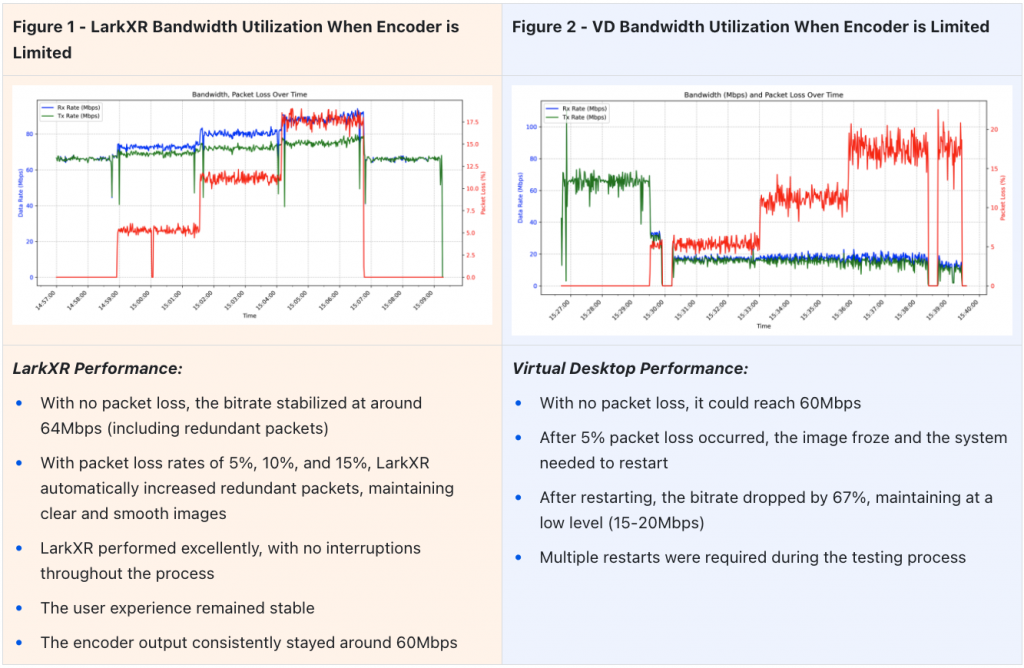
Figure Legend: The blue solid line represents the data bitrate received by the network impairment meter, the green solid line represents the data bitrate sent by the network impairment meter, and the red solid line represents the packet loss rate.
Scenario #2: Bandwidth Compression Test - Smart Adaptation Under 50Mbps Bottleneck
Test Purpose: Observe network utilization when the encoder’s maximum output bitrate is greater than the network bandwidth.
Test Parameters:
- Encoder maximum output bitrate: 60Mbps
- Network bandwidth: Limited to 50Mbps
- Packet loss settings: No packet loss, random packet loss rates of 5%, 10%, 15%
Expected Results: Effectively detect network bandwidth at around 50Mbps and appropriately reserve bandwidth to absorb delay jitter caused by uneven encoder output.
Test Results:
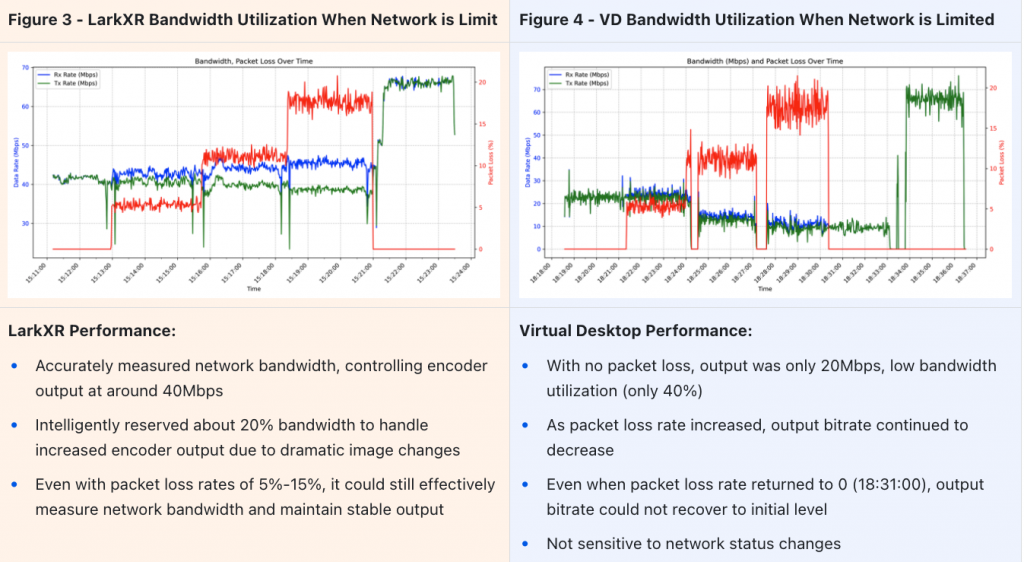
Figure Legend: The blue solid line represents the data bitrate received by the network impairment meter, the green solid line represents the data bitrate sent by the network impairment meter, the red solid line represents the packet loss rate.
Scenario #3: Dynamic Network Challenge - Performance Under Bandwidth Fluctuation
Test Purpose: Observe changes in encoder output when network bandwidth changes.
Test Parameters:
- Encoder maximum output bitrate: 60Mbps
- Network bandwidth: Changing to 30Mbps-50Mbps-40Mbps
- Packet loss settings: No packet loss
Expected Results: Quickly adjust encoder output bitrate according to network bandwidth changes.
Test Results:
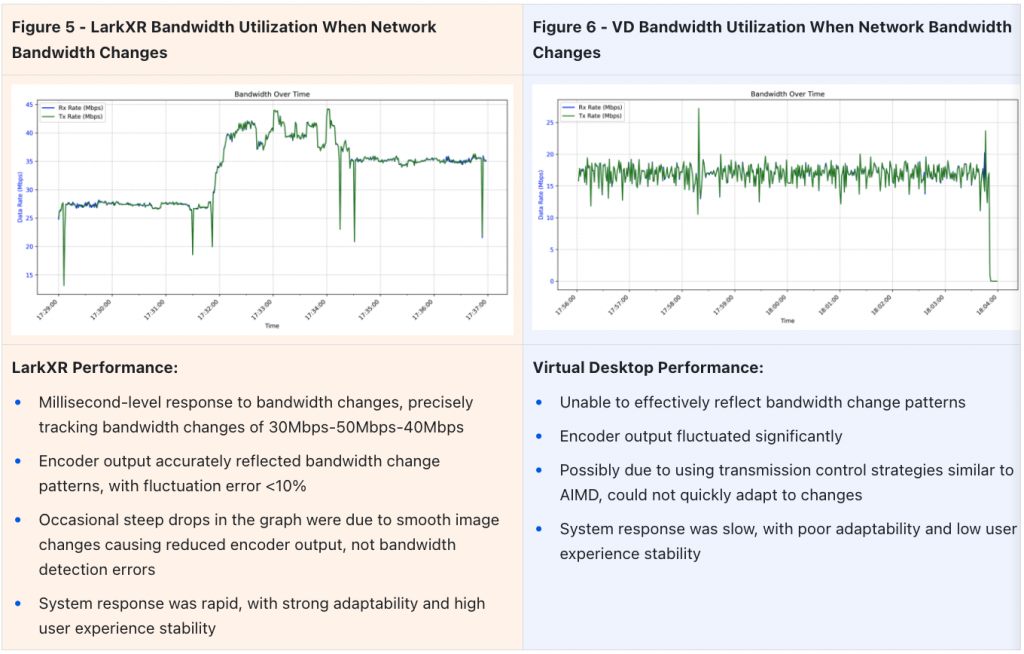
Figure Legend: The blue solid line represents the data bitrate received by the network impairment meter, the green solid line represents the data bitrate sent by the network impairment meter.
More Tests: Limitations of Headset Devices' Built-in Streaming Tools
In addition to VD, we also tested several other headset devices’ built-in streaming tools on the market. In these simple network scenarios, these products were almost unusable, with test results as follows:
Test Scenario #1: Unlimited Bandwidth, Encoder Maximum Output Set to 100Mbps

Conclusion: Even with adequate bandwidth, once there was a slight 2% packet loss, the system became completely unusable.
Test Scenario #2: Bandwidth Limited to 50Mbps, Encoder Maximum Output Set to 100Mbps
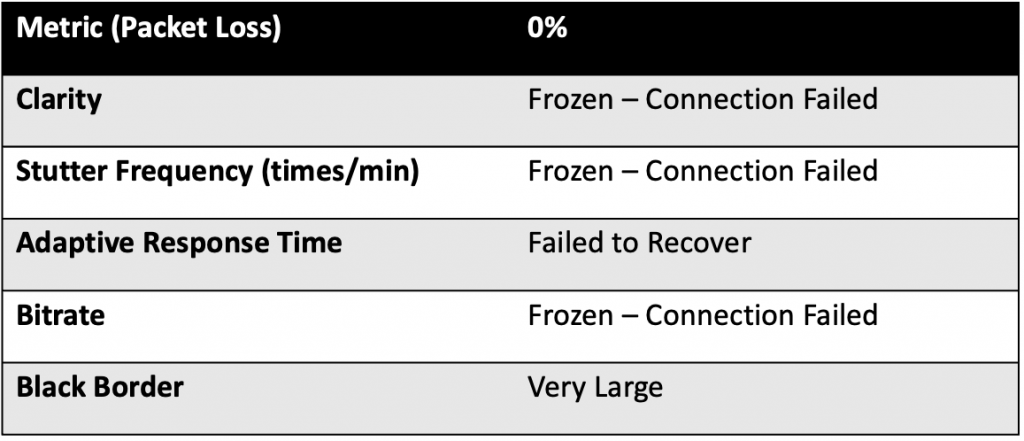
Conclusion: When bandwidth was less than the encoder setting, the system was completely unusable. This indicates that the product outputs at a constant rate according to the headset settings, with almost no network adaptive function, heavily relying on the user’s subjective setting of encoder bitrate. Once the set bitrate is higher than the actual network bandwidth, the product becomes unusable, greatly challenging user patience.
Test Scenario #3: Bandwidth Limited to 50Mbps, Encoder Maximum Output Set to 30Mbps

Conclusion: When the encoder setting was less than the bandwidth limit, it was basically usable with no packet loss, but once there was 5% packet loss, the system would freeze. This further proves that such products lack both bandwidth adaptive capability and effective redundant error correction mechanisms, making them unsuitable for cloud VR scenarios.
Product Comprehensive Performance Evaluation
Compared to the various limitations of other products in complex network environments, through three sets of rigorous comparative tests, LarkXR demonstrates excellent network adaptability, able to adjust encoder output in real-time according to network bandwidth changes and packet loss rate changes. Moreover, bandwidth prediction is smoother, performance is more efficient, and user experience is superior.

LarkXR's network transmission control strategy demonstrates clear technical advantages in cloud VR application scenarios:
- Strong packet loss resistance capability: Can maintain stable transmission even with high packet loss rates of 15%; while other products fail to connect with just 2% packet loss
- Intelligent bandwidth detection and allocation: Automatically reserves 20% buffer space for image changes, avoiding connection problems caused by improper bandwidth settings in other products
- Millisecond-level response to network bandwidth changes: Highly adaptive, can quickly respond to bandwidth fluctuations of 30-50Mbps
- Smooth and stable bandwidth prediction: Fluctuation error less than 10%, ensuring consistent image quality
- Efficient redundancy mechanism: Guarantees high-quality transmission, significantly reduces inter-frame delay, and avoids sense of dizziness
As cloud VR applications become increasingly popular, Paraverse’s LarkXR, optimized for complex network environments, provides users with a smoother, more stable, and more immersive experience, truly breaking through network limitations and leading cloud VR technology to new heights. Whether for education and training, remote collaboration, or gaming entertainment, LarkXR can provide exceptional cloud VR experiences under various real-world network conditions.
LarkXR offers enterprises a cost-effective real-time cloud rendering and streaming service.
This article, through network challenge environment testing, not only compares performance with VR streaming products but also demonstrates LarkXR’s technical advantages in cloud VR application scenarios. LarkXR as an out-of-the-box enterprise-grade real-time Cloud XR Streaming PaaS, also excels in rendering performance, computing power scheduling, and heterogeneous terminal support, providing complete backend management and front-end access systems along with multi-scenario functional components, offering enterprises a cost-effective real-time cloud rendering and streaming service.
For more detailed information about LarkXR’s core advantages, please read “The Cloud XR Streaming Definitive Guide 2025: LarkXR VS. UE Pixel Streaming”

